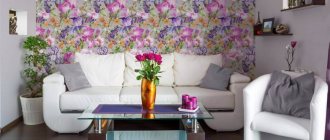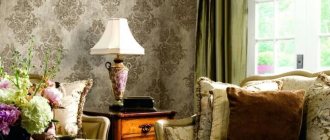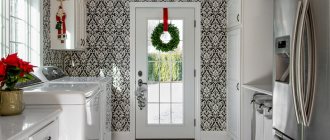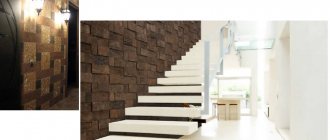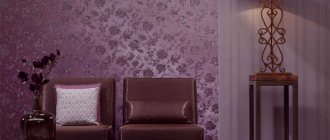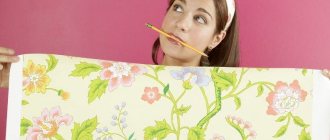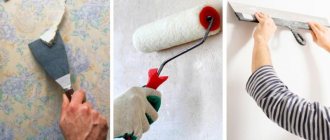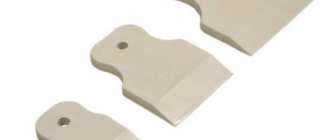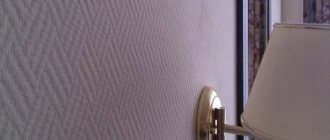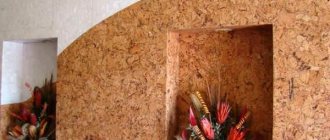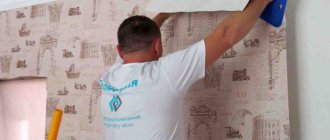Some finishing materials, even those intended for indoor use, can be not only harmful, but also hazardous to health. Since wallpaper is still the most common finish among other market offerings, you should understand which of them are the safest for health.
The choice of wall cladding from an environmental point of view should be based on several factors. This is not only the presence or absence of harmful chemical compounds in the composition, but also the ability of the canvas to freely pass air through itself. After all, if you stick “non-breathable” wallpaper in the bedroom, after a while you can understand that relaxing in such a room is not very comfortable. Before you go to the store, you should understand the question of which wallpaper is safe for health.
Which products are environmentally friendly?
The most favorable for creating a comfortable indoor microclimate are wallpapers that are made from natural raw materials. Ideally, artificial chemical components should not be among the ingredients at all. At all times, paper sheets were considered the most harmless, which, however, have many negative characteristics.
Firstly, they do not look as attractive as other types of wallpaper. Secondly, they are the least wear-resistant. Thirdly, even if the slightest dirt appears on such wallpaper, it will be quite difficult to get rid of unsightly stains, since a slight impact on the material will immediately lead to damage to the outer paper layer.
Eco wallpaper for wall decoration: characteristics, differences
Made from natural raw materials: wood, silk, papyrus, etc. Hence their properties: safety, strength, vapor permeability, thermal insulation. More details about each characteristic:
- 1) Natural materials practically do not emit hazardous substances. Some of them kill harmful microbes, that is, they are antiseptics.
- 2) Cork, bamboo and fiberglass wallpapers are durable and moisture resistant due to the high density of the raw materials. This explains their durability, practicality, and versatility.
- 3) Paper, wood and other natural raw materials allow steam particles to pass through pore channels, which ensures air exchange. This reduces the risk of mold growing on the walls.
- 4) Natural materials – heat insulators. Eco wallpaper keeps the room warm.
Eco wallpapers differ among themselves in material (paper, wood, bamboo, papyrus, silk, non-woven fabric), complexity of the pattern, and additional applications (fireproof and other impregnations).
Environmental safety factors
If you want to choose the healthiest wallpaper for your home, you should be guided by several factors. The first of these is the type of materials used in production. It is the raw materials in the composition that determine the harmlessness of the finish. It must be made on a natural basis. Even if the technology involves the use of a synthetic base, it can lead to allergic reactions.
The second factor is the glue used. Not only the base itself can be environmentally safe or harmful to health. The glue used to connect layers or components to each other can also be made from a harmful binder. If you are wondering which wallpapers are not harmful to health, you should pay attention to the fact that the glue should be made on a starch basis.
Since recently the issue of recycling materials has become particularly acute on a planetary scale, you should select wallpaper that ensures safe disposal. When a consumer is interested in the question of which wallpaper is more environmentally friendly and harmless to health, he should be guided by the fact that the composition of the canvases does not include polymers. They are difficult to recycle, and when exposed to fire they can release harmful substances. This is important not only at the stage of disposal, but also during operation. If a fire occurs, the finishing itself can not only pose a danger in terms of rapid ignition and further spread of fire, but also begin to release harmful substances into the air.
A brief overview of wallpaper by degree of harmfulness
In order to understand the question of whether vinyl wallpaper is harmful or not or to understand how harmless this or that type of wall covering is for decoration, this article will provide a brief overview of the most common types of wallpaper, as well as a list of harmful chemical compounds that may be included in their composition.
In addition, the reader will be offered brief instructions that will help him choose the safest wallpaper for his own home.
End cut of a roll of vinyl sheet.
Chemicals in wallpaper
Everyone knows that the most beneficial for human health are finishing materials made from natural raw materials without the addition of artificial components. However, in modern conditions this is practically impossible, since without the use of chemical additives it is very difficult to achieve the required performance qualities of the material.
Today, even the most harmless wallpaper contains a certain amount of chemical components, while the most dangerous of them, which can cause significant harm to human health, are presented below.
- The most common compound used in many finishing and building materials is polyvinyl chloride, or PVC for short. It is included in almost all vinyl wallpapers, so more detailed information about it will be discussed in the next section.
- Benzene is a toxic substance and has pronounced carcinogenic properties. It can be part of the protective coating of low-quality washable wallpaper, which should not be used for pasting bedrooms, children's rooms and residential premises.
- Formaldehyde is also a highly toxic substance that can evaporate into a room for a long time. Can be included in washable laminated wallpaper. Not recommended for use in conditions of high humidity and elevated temperatures.
- Organic solvents based on acetone, nitrobenzene, xylene or toluene can be the basis for paint on low-grade wallpaper from an unscrupulous manufacturer. During evaporation and prolonged exposure, they can cause health problems.
- Also, some dyes, mostly dark colors, may contain compounds of lead or other heavy metals that are poorly excreted from the body, disrupting the function of the liver and kidneys.
The photo shows a universal adhesive for heavy wallpaper.
Advice! In addition to the wall covering material, some types of wallpaper adhesive that are produced in violation of sanitary standards may pose a separate danger, therefore, for gluing any covering, it is recommended to use only adhesives from a reliable manufacturer.
Features of vinyl coating
Among other materials for decorative wall decoration, a special place is occupied by the so-called vinyl wallpaper, consisting of a paper, non-woven or fabric base, onto which a solid or textured layer of polyvinyl chloride is applied, forming a specific pattern or repeating the texture of any material.
Vinyl covering in the kitchen interior.
This coating has become widespread due to its high aesthetic qualities and good performance properties.
The wallpaper is quite moisture-resistant, which makes it easier to care for the surface of the walls, has high wear resistance and durability, but before purchasing it, you should still figure out whether vinyl wallpaper is harmful when covering the rooms of a residential apartment.
- First of all, it must be said that the degree of harmfulness of polyvinyl chloride largely depends on compliance with production technology. In fact, during operation, PVC can release active chlorine into the atmosphere, however, subject to technical regulations, modern polyvinyl chloride products comply with sanitary standards, so the release of active substances does not exceed permissible limits.
- PVC film is not vapor-permeable and does not have breathable properties, so condensation can accumulate in the thickness of the wallpaper base or under it, which contributes to the formation and development of mold.
- Another negative quality of vinyl coating is its fire hazard. PVC itself does not support combustion and has a self-extinguishing property, but under the influence of high temperatures it can melt and release caustic smoke and toxic gases into the atmosphere.
- There is an opinion that silk-screened wallpaper is much safer than other types, but you should know that the basis of the silk-screened image is a coating of PVC film, to which artificial or natural silk fibers have been added.
The development of mold under the wallpaper.
Note! Modern vinyl wallpaper allows you to minimize the number of harmful factors. Thus, using new technologies, solid vinyl film is made porous, which provides it with breathable properties, and antiseptics and antifungal additives are introduced into the base composition, which together significantly reduces the likelihood of mold formation.
Safe wallpaper
Particular care should be taken when choosing wall coverings for a bedroom, living room or children's room, since residents spend the most free time in these rooms.
Among the safest materials for health, there are several types of wall coverings.
- Classic wallpaper on a paper or fabric basis made from natural raw materials most fully meets the requirements of environmental and sanitary safety. They are breathable and do not emit harmful substances. Another positive quality of this coating is the ease of gluing it yourself and the relatively low cost.
Environmentally friendly textile wallpaper on a paper basis.
- A relatively new type of coating, called glass wallpaper , combines the environmental friendliness and lightness of cellulose paper and the high protective properties of natural quartz glass. This coating is absolutely moisture resistant and at the same time does not contribute to the development of mold and pathogenic bacteria. In addition, it is highly wear-resistant and does not emit harmful substances into the air. Its only drawback is its rather high price compared to other types of similar materials.
Assortment of fiberglass wallpaper.
- Another type of wall covering, which differs significantly from the usual roll materials, is popularly called liquid wallpaper . It is a plastic building mixture that is applied to a previously prepared wall, and after drying it forms a durable, moisture-resistant coating with a characteristic chaotic pattern of selected colors.
As for the question: is liquid wallpaper harmful, it cannot be answered in the affirmative, since their base consists of mineral components of natural origin and practically does not contain artificial components.
Selection rules
If you are dealing with the question of which wallpapers are not harmful to health, you should immediately pay attention to paper canvases. Their simple composition without additional complex compounds explains their low cost. The canvases are light and very thin, so they are easy to stick to the wall. Since the finish breathes, it does not require bactericidal substances, which in other similar cladding prevent the occurrence and spread of mold and mildew. But even this type of decorative material can be dangerous to health because after 5 years it begins to deteriorate and release paper dust, which acts as an active allergen. Therefore, it is recommended to change the wallpaper after a certain period of time.
When a consumer decides which wallpaper is not harmful to health, he should try to abandon the vinyl variety. It is divided into breathable and non-breathable fabrics. It is almost impossible to visually distinguish the former from the latter.
Attention! Breathable vinyl wallpaper is made on a polymer base, but has pores through which air passes.
Non-woven wallpaper can be harmless or hazardous to health. It all depends on what the outer layer is made of. The base is non-woven fabric, but on the outside there may also be vinyl, which is dangerous. If the non-woven fabric is combined with a paper outer layer, then the fabrics do not lose their ability to breathe. But even in this case, production involves the use of polymer additives.
Eco-friendly wallpaper for the bedroom and more
Given the rate at which our planet's natural resources are being depleted and some are disappearing altogether, it becomes more and more important every day to conserve what we have and make the best choices when purchasing goods for everyday life.
By avoiding clichés, being interested in what's new and exploring different alternatives, we can decorate our homes with impeccable style and without harming valuable environmental resources. Choosing eco-friendly wallpaper is an important area where discerning taste and eco-consciousness can come together.
Wallpaper from the Swedish manufacturer Eco Borastapeter
Types of eco-friendly wallpaper
When deciding which wallpaper is the safest for health, you should pay attention to some types of modern finishes. They may cost a little more, but they look much more attractive than their harmful counterparts. Among other market offerings, we can highlight fiberglass wallpaper, which not only breathes, but also allows the consumer to color the canvases taking into account their own aesthetic preferences.
Vegetable
This eco-friendly finish is based on natural fibers, namely:
- nettle;
- cane;
- sisal;
- bamboo;
- jute.
A more expensive type of such natural wallpaper is made from valuable wood. The raw material takes the form of the thinnest layer possible, which is connected to a non-woven or paper base. Production technology involves the use of:
- traffic jams;
- cherries;
- veneer;
- apricot
On sale you can find finishing, the outer layer of which is made of leaves.
Woody
When consumers are wondering which wallpapers are healthy, they should look to environmentally friendly wood-based finishes. We are talking about structural canvases, which are at the peak of popularity in Europe today. This cladding has all the advantages of non-woven wallpaper. In addition to the fact that such wallpapers are safe, they are also very tear-resistant. A bonus for the consumer is the ability to repaint the cladding.
Paper
If there is a need to quickly and inexpensively update the walls in a room, you should choose wallpaper that is not at all harmful to health. We are talking about paper cladding, which, perhaps, cannot be found more environmentally friendly. The material can be single-layer or multi-layer. On sale you can find structured and embossed varieties of such wallpaper, the latter of which are cached and made on a paper basis.
Made from recycled materials
Such wallpaper is suitable for those who are concerned not only about meeting their own needs, but also about the fate of the planet. Do not assume that finishing materials made from recycled materials will look unattractive. On the contrary, today these are the latest trends in interior design.
The production technology of such cladding may involve the use of:
- glass;
- paper;
- metal
Moreover, in the United States today, more than 80% of wallpaper is made from recycled glass. The appearance of such paintings is truly unique, since the decorative layer is formed from a mosaic. If the consumer is interested in which wallpapers are more harmless than others, he should pay special attention to finishes that have low water absorption, which means they can be used even in damp rooms.
Textile
If there is not enough air in the room and you want the coating to contain only natural ingredients, you should choose textile wallpaper. Their varieties are offered in a wide range. The following varieties can be found on sale:
- linen;
- jute;
- silk;
- jacquard;
- cotton;
- velor;
- felt
If desired, you can choose synthetic wallpaper or paper-based trim. Fabric cladding offers a wide range of models. This is aesthetics at its highest and environmental friendliness. It is based on natural threads and natural dyes. The backing can be non-woven or paper. An additional advantage of such wallpaper is its resistance to light.
Non-woven
If a housewife is interested in the question of which wallpaper will always remain clean, she should consider non-woven wallpaper, which is ready to last a truly long time. The top coating is responsible for the quality here. But environmental friendliness and excellent quality characteristics can be overshadowed by the complex process of gluing the canvases. They have an impressive weight, so they require a special approach and thick glue. The bonus is that the coating can be painted in any color.
Attention! In order to paint non-woven wallpaper, you should choose a water-based composition. It is not only suitable for this type of finishing, but is also completely safe for health.
Made from fiberglass
When choosing environmentally friendly wallpaper, you should evaluate the harm of other types of finishes and consider glass wallpaper. They are suitable for painting and are made from glass raw materials. Due to this, the coating remains resistant to fire.
The consumer can count on wear resistance and durability. With the help of such cladding you can create a unique interior in almost any style. The canvases can be based on:
- limestone;
- clay;
- soda;
- quartz sand.
All these are natural components with absolute environmental friendliness.
Cork and other coverings
The production process involves the use of raw materials in the form of oak bark. Wallpaper can have a backing made of non-woven or paper. The color palette is usually limited to warm shades and is not rich.
The production technology involves grinding oak bark, which is combined with an adhesive substance. The resulting slurry is applied to a base made of paper or non-woven fabric. An additional advantage of this coating is its ability to reduce noise.
If we consider other types of cork wallpaper, they are:
- self-adhesive;
- without base;
- liquid.
With the help of the former, repairs can be carried out in the shortest possible time. Installation of canvases is greatly simplified. Such dense ones can be used to paste over not only walls, but also door panels, as well as furniture. The most environmentally friendly wallpaper is baseless wallpaper, which is fragile.
Attention! Liquid cork wallpaper is used not only for interior surfaces, but also for building facades. And application is carried out mechanically or using a spatula. Therefore, the liquid variety of cork wallpaper only has this name. In fact, it is something between decorative plaster and liquid wallpaper.
4) Eco-friendly wallpaper glue.
To ensure that wallpaper does not lose its environmentally friendly properties, you need to use certain compositions that will not only provide good adhesion to the surface, but also preserve their positive characteristics. When choosing environmentally friendly wallpaper adhesive, pay special attention to those compounds that are labeled as environmentally friendly and, of course, follow the recommendations of the manufacturer itself.
By using environmentally friendly wallpaper, you provide yourself and your family with comfortable and safe living and preserve their health.
Consumer reviews and expert advice
- According to consumers, the harm of vinyl wallpaper is quite real. Only some types of such paintings do not have a negative impact on human health. But if the material ignites, it can begin to release formaldehyde, and its harm is already widely known.
- Before renovating the bathroom, consumers are advised to choose wallpaper that is not only harmless, but also will not lose its appearance from constant contact with moist air. The safest are liquid wallpapers, which are based only on cellulose fibers and fabric, and they are not even connected to each other with an adhesive substance. But such finishing, according to buyers, quickly becomes unusable in a bathroom environment.
- Experts do not recommend purchasing Chinese analogues of wallpaper. Most often, such finishing is cheap, but is made from extremely low-quality raw materials. Even when choosing the most harmless wall decoration, you may come across a material that contains harmful compounds.
Who needs hypoallergenic wallpaper?
Research shows that in the modern world, every fourth person suffers from some form of allergy. It is not surprising that the range of buyers interested in wall decoration with hypoallergenic properties is growing every year.
Faced with poor ecology and dirt at work and on the streets of big cities, people are increasingly striving for the cleanliness of their homes. But there is a category of townspeople for whom this cleanliness is vital - allergy sufferers and children.
For the first, maximum purity is necessary because this will reduce the use of medications that suppress the manifestations of allergies, or even abandon drug treatment altogether. Secondly, a hypoallergenic environment will prevent disease.
But the circle of interested parties is not limited only to private residential premises. Hotel managers who care about the health of their guests, directors of kindergartens and schools, heads of medical institutions - all of them not only think about the maximum cleanliness of the premises they are entrusted with, but also comply with strict sanitary standards. These standards also relate to the quality of finishing.
Increasingly, owners of office premises are also thinking about the hypoallergenic characteristics of finishing, as they understand that their productivity and, literally, the atmosphere in the team depends on the well-being of employees.
Increasing demand from year to year leads to manufacturers expanding their range of universal and specialized hypoallergenic wallpaper.
Which paper wallpaper to choose?
When choosing wallpaper, you should consider its ability to allow air to pass through. In this case, paper wallpaper is a win-win option. But there are also advantages to such wallpaper.
There is good air exchange between the wall and the air in the room; mold and mildew do not form on the walls.
The low price of single-layer wallpaper makes it possible to change the decor in the apartment every three years.
But recently, consumers have been making their choice in favor of expensive multi-layer imported wallpaper with high-quality patterns and photo printing. The price of such wallpapers is high, they stick for a long time. Excessive demands are placed on the quality of such wallpaper.
Modern photo wallpaper on a thick paper base, high quality, conveying the image as realistically as possible. Nature, cities, and different natural textures are especially popular.
The end walls are covered with story wallpaper. If you apply wallpaper correctly and successfully, the room will appear taller and wider, as if there is an additional volume of air.
The main disadvantages of paper wallpaper:
- odor absorption;
- fear of moisture.
Therefore, it is better not to use such wallpaper for the kitchen and bathroom.
Try to choose wallpaper that is denser; it accumulates less dust, which means less harm to health.
Paper wallpaper of the M brand is not recommended for pasting walls, children's rooms, and bedrooms. Such wallpaper is wash-resistant. They are perfect for the kitchen.
Factors to consider when choosing safe products
The presence of any of these markings indicates the safety of the wallpaper.
To protect yourself from purchasing dangerous products, follow these simple recommendations:
- Products must have a hygiene certificate.
- It is better to choose products from well-known manufacturers.
- A low price most often indicates an appropriate level of quality.
- The packaging must have an environmental safety sign.
Advice! Do not forget that wallpaper is glued to a special compound, and the requirements for it are no lower than for the main coating. And if paint is used, it must also be safe; it is best to purchase a water-based composition.
Different types of wallpaper - which ones are harmful to health?
Published by: Arthur Kanapatsky 0
Few people think that even the most common types of finishing can be harmful to health. In this article we will look at such a covering as wallpaper. This material is the subject of constant debate about whether it is harmful to health or not, as well as which specific wallpapers may be a source of danger.
Vinyl wallpaper: is it harmful to health?
Everyone knows that paper wallpaper is harmless, so we didn’t pay attention to it. Let's consider the type of wallpaper that raises the most questions among consumers about environmental friendliness. Namely, vinyl on a non-woven basis.
- Non-woven fabric is a paper-like material made from chemically modified cellulose. If we consider that similar technologies are used to produce viscose or the familiar cellophane, we can conclude that non-woven fabric itself does not pose any danger to humans. By the way, it is used in the clothing industry as lining fabric.
- In the case of wallpaper, interlining is also actually a lining, on top of which another, now decorative, layer is applied - or simply a white relief intended for painting.
- In the first case, it is a layer of foamed vinyl, in the second, it is often paper. You can hardly find pure paper wallpapers today, and they are not in great demand due to their short service life and limited assortment; the aesthetics of the coating are also not very demanding.
- It’s different when there is a layer of decorative vinyl on top of the base! Their eyes widen, they want to buy everything, and few people remember the possible harm of non-woven vinyl wallpaper. But there is no harm, except for a temporary smell that disappears after a few days.
It is the vinyl surface of the wallpaper that gives a stunning aesthetic effect.
- People with allergic rhinitis may react to it, but as already mentioned, it can also be a reaction to the glue. You just need to not rush to spend the night in a room that has just been renovated, but give it a few days to dry and ventilate well. By the way, not only wallpaper, but also all types of building mixtures and decorative coatings have a chemical smell.
- In general, non-woven wallpaper, the harm of which has not been proven by anyone, has many advantages that outweigh the temporary inconvenience. They are hygienic, do not fade in a year or two, like paper ones, and multi-layering allows you to achieve incredible visual effects. Silk-screen wallpaper, for example, is also vinyl, only silk threads are placed in the top layer.
Vinyl wallpaper with a beautiful texture
The canvases are easily glued to the wall; they do not even need to be lubricated with glue (only the wall). They do not deform, do not bubble, and do not wrinkle. Of all the possible options, vinyl-coated non-woven wallpaper is best suited for finishing new buildings - other types of roll coverings may tear in places where shrinkage cracks appear.
